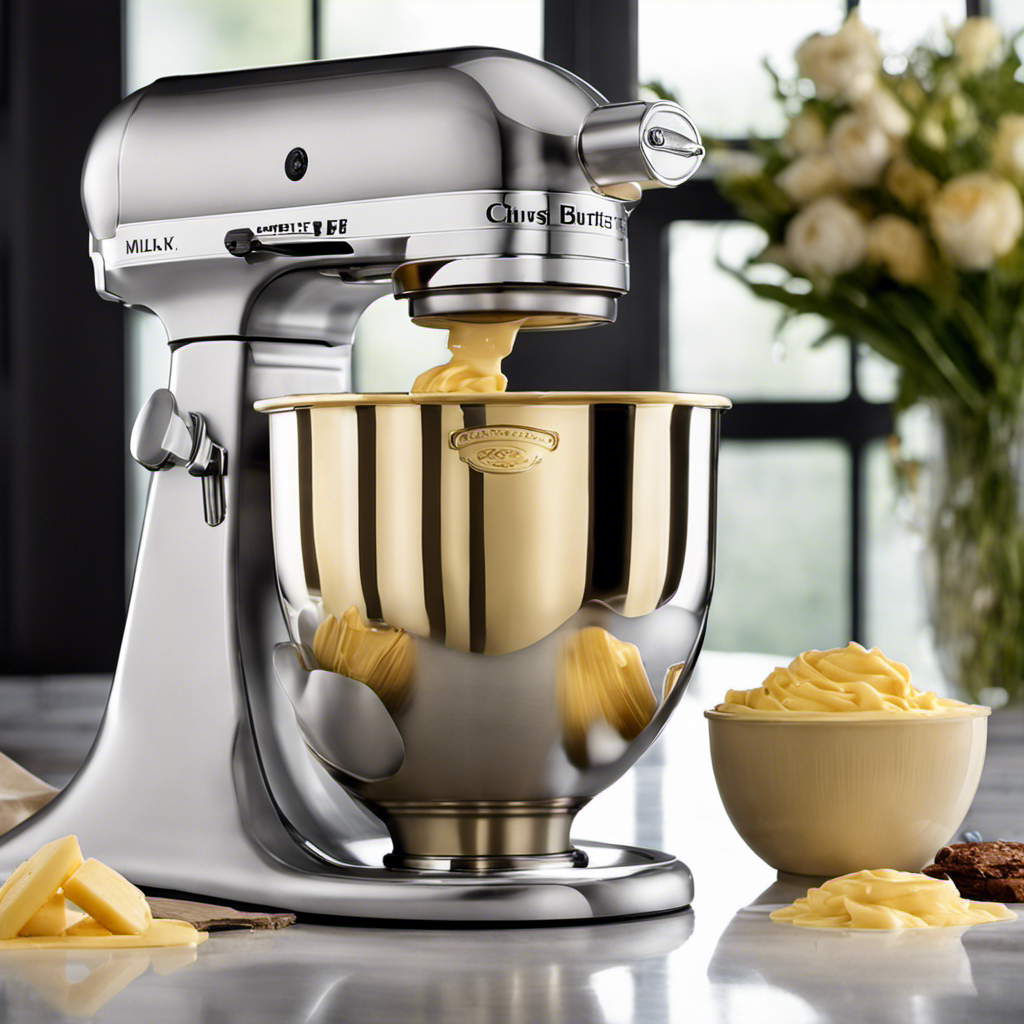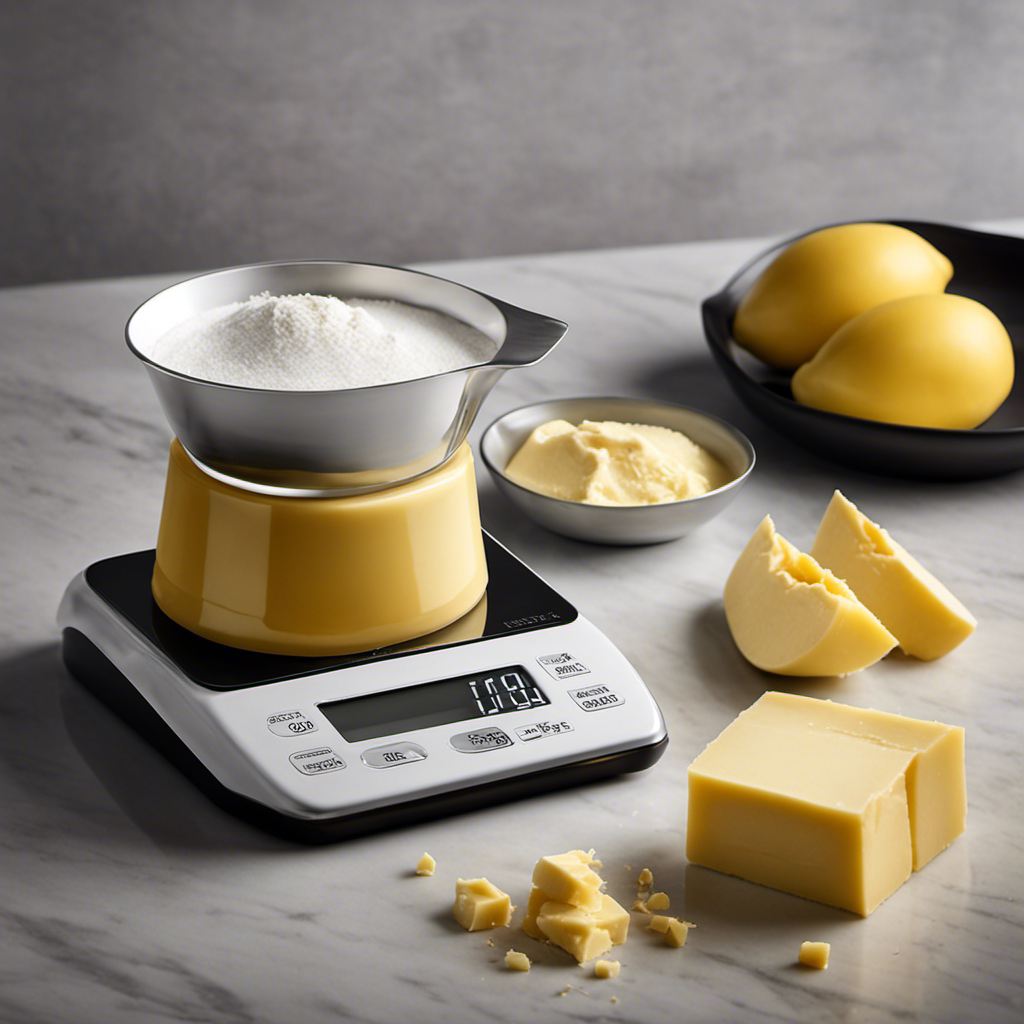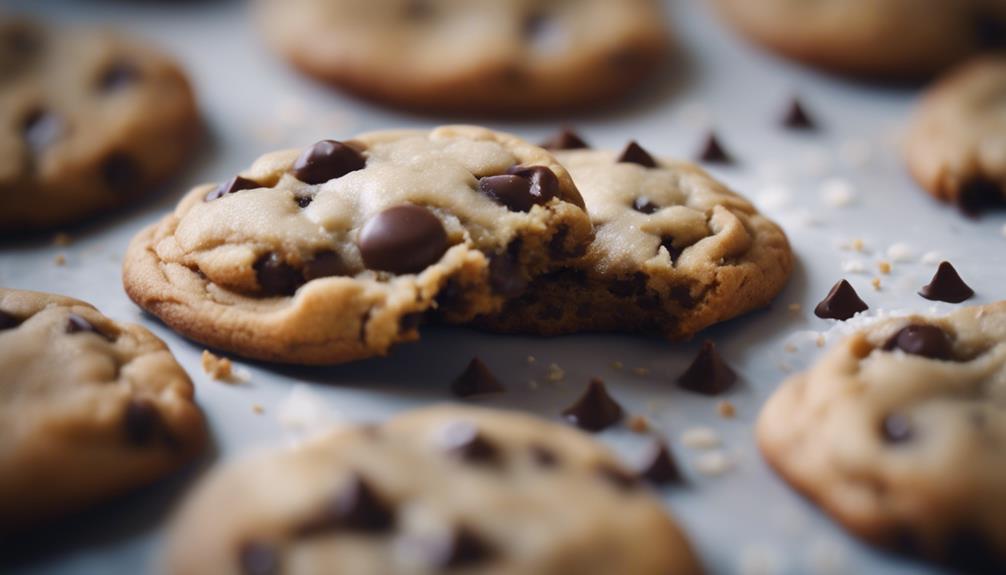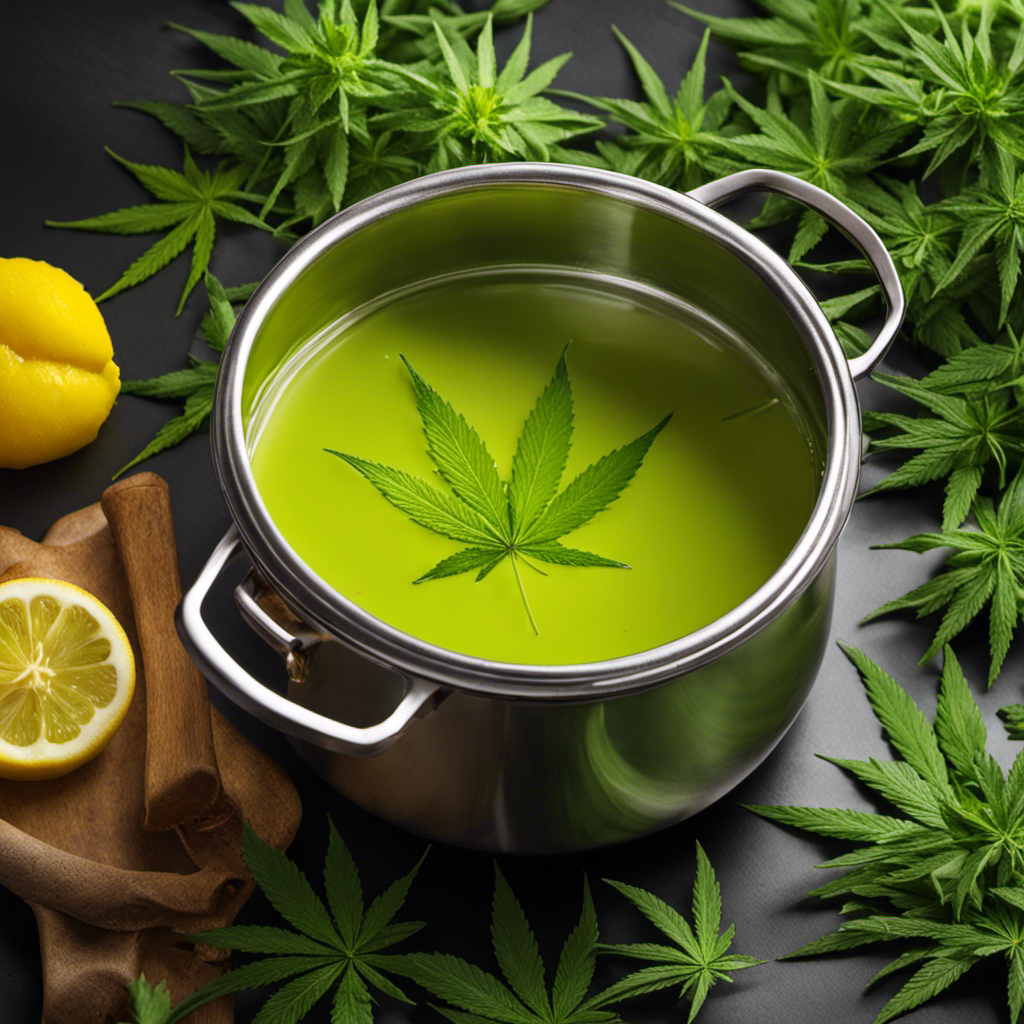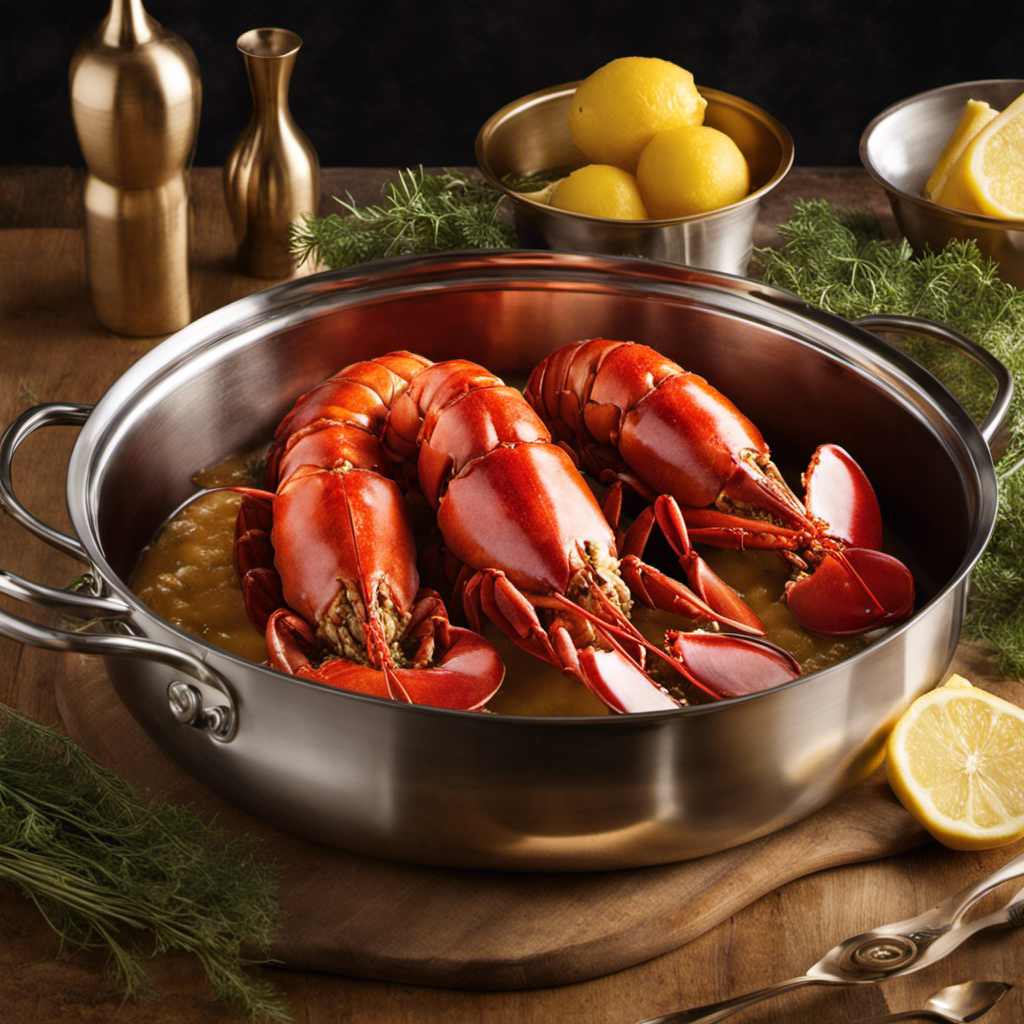As someone who loves butter, I have always been intrigued by the alchemical process of turning cream into that golden, spreadable delight.
Join me as we delve into the science behind butter making and uncover the answer to a burning question: How much butter does 32 oz of cream make?
In this article, we’ll explore the precise butter-to-cream ratio, the step-by-step churning process, and the factors that can affect butter yield.
Get ready to churn up some knowledge and indulge in the delicious world of homemade butter.
Key Takeaways
- Churning cream separates the fat globules from the liquid to form butter.
- Adjusting the butter-to-cream ratio determines the yield and flavor of the butter.
- Cream consistency affects the final outcome of butter, with higher fat content resulting in firmer butter.
- Factors such as the fat content of cream, churning method, and quality of cream can affect butter yield and production.
The Science Behind Butter Making
Do you know how cream turns into butter through a process called churning? It’s fascinating!
Butter making techniques involve separating the fat globules from the cream and then agitating them until they clump together to form butter. This can be done by hand using a jar or churn, or with the help of a mixer or blender.
The churning process breaks down the fat globules, releasing the fat and causing it to stick together. The result is a creamy, spreadable butter. Homemade butter has several nutritional benefits compared to store-bought varieties. It is rich in healthy fats, vitamins A and D, and contains no additives or preservatives. Plus, it tastes amazing!
Understanding the Butter-to-Cream Ratio
When it comes to making butter, achieving the ideal consistency is crucial. The butter should be firm enough to hold its shape but soft enough to spread easily.
Measuring the cream accurately is also important, as the butter-to-cream ratio determines the yield of butter.
Lastly, adjusting the ratios for flavor allows for customization, whether one prefers a more buttery taste or a milder flavor.
Ideal Butter Consistency
To achieve the ideal butter consistency, you’ll want to make sure the cream is at room temperature before churning it. This ensures that the cream will emulsify properly and result in a smooth and creamy butter. If the cream is too cold, it will take longer to churn and may not incorporate air properly, resulting in a denser texture. On the other hand, if the cream is too warm, the butter may become greasy and oily.
When it comes to flavor adjustments, you can add a pinch of salt to enhance the taste of the butter. Additionally, you can experiment with different flavorings such as herbs, spices, or even citrus zest to create unique and delicious flavored butters. Just make sure to adjust the amount of flavorings according to your taste preferences.
Here’s a table summarizing the ideal butter consistency and flavor adjustments:
| Ideal Butter Consistency | Flavor Adjustments |
|---|---|
| Smooth and creamy | Pinch of salt |
| Not too cold or warm | Herbs and spices |
| Properly emulsified | Citrus zest |
Measuring Cream Accurately
Using a measuring cup, you’ll need to ensure you have the correct amount of cream for the butter-making process. Measuring accuracy is crucial to achieve the desired consistency in the final product.
To accurately measure your cream, start by pouring it into a liquid measuring cup. Make sure you level off the top of the cream with a straight edge, such as a spatula, to ensure accuracy.
It’s important to note that the consistency of the cream will affect the final outcome of the butter. For a firmer butter, you’ll want to use cream with a higher fat content. On the other hand, if you prefer a softer butter, opt for cream with a lower fat content.
Adjusting Ratios for Flavor
If you want to enhance the flavor of your butter, you can adjust the ratios of different ingredients. Experimenting with ratios allows you to customize the taste to your liking.
One way to adjust the flavor is by adding more salt. Salt enhances the natural taste of butter and can make it more savory. You can start by adding a pinch of salt and gradually increase the amount until you find the perfect balance.
Another ingredient you can experiment with is herbs or spices. Adding a sprinkle of dried herbs like thyme or rosemary can give your butter a unique and flavorful twist. Don’t be afraid to get creative and try different combinations to find the flavor that suits your preferences.
Adjusting flavors through ratios is a fun and delicious way to elevate your butter to the next level.
Step-by-Step Butter Churning Process
When it comes to churning cream into butter, there are a few key points to keep in mind.
First, you’ll need some specific butter-making equipment, such as a butter churn or a stand mixer with a whisk attachment. These tools will help you achieve the best results.
Additionally, there are some tips that can improve your churning process. For example, using cold cream can make a difference. Allowing the cream to ripen is another important step. And finally, maintaining a consistent churning speed is crucial.
Churning Cream Into Butter
To churn cream into butter, you’ll need a churn or a stand mixer. Churning is the process of agitating the cream to separate the fat globules from the liquid. There are different churning techniques you can use, such as the traditional hand-cranked churn or a modern stand mixer with a whisk attachment. Both methods work effectively, but the stand mixer provides convenience and saves time.
When churning cream into butter, it’s important to troubleshoot common butter making problems. One common issue is over-churning, which can result in the butter becoming grainy and the buttermilk separating. To avoid this, you should stop churning as soon as the butterfat has separated from the liquid. Another problem is insufficient churning, leading to a soft and greasy butter. In this case, continue churning until a solid mass of butter forms.
Now that you understand the churning process and how to troubleshoot common problems, let’s move on to the next section about the necessary butter-making equipment.
Butter-Making Equipment Needed
The necessary equipment for making butter includes a churn or stand mixer, a whisk attachment, and troubleshooting knowledge. When it comes to butter making techniques, having the right tools is essential. A churn or stand mixer will help you achieve the desired consistency by agitating the cream. A whisk attachment is another option if you don’t have a churn or stand mixer. It will require more effort, but the result will be worth it. Additionally, troubleshooting knowledge is crucial to ensure a successful butter making process. Understanding common issues such as graininess or separation can help you troubleshoot and adjust your technique accordingly. Below is a table summarizing the necessary equipment for making butter:
| Equipment | Purpose |
|---|---|
| Churn or Stand Mixer | Agitate cream |
| Whisk Attachment | Alternative to mixer |
| Troubleshooting | Identify and fix problems |
With the right equipment and troubleshooting knowledge, you’ll be well-equipped to make delicious homemade butter.
Tips for Better Churning
Having the right equipment and knowing the proper technique is crucial for achieving a smooth and creamy consistency when making homemade butter. To improve your churning process, there are a few techniques you can try.
First, ensure that your cream is at the right temperature, around 60-65°F, as this affects the separation of butterfat from the liquid.
Second, use a churn with a paddle or dasher that allows for efficient agitation and proper aeration. A continuous and steady churning motion is essential for optimal butter formation.
Additionally, troubleshooting common butter making problems can enhance your results. If your butter is too soft, try chilling the cream before churning or using colder water during the washing process. Conversely, if your butter is too hard, consider increasing the churning time or incorporating slightly warmer water during washing.
Factors Affecting Butter Yield
Factors affecting butter yield can be divided into two main categories: the fat content of the cream and the churning method used. The fat content of the cream is a crucial factor in determining the amount of butter that can be produced. Cream with a higher fat content generally yields more butter than cream with a lower fat content.
In addition to the fat content, the churning method used also has an impact on butter yield. The agitation and temperature during churning can affect the separation of the butterfat from the buttermilk. Proper churning techniques, such as maintaining the correct temperature and duration, can optimize butter yield.
It is important to note that the quality of the cream also plays a significant role in butter yield. Fresh, high-quality cream generally produces a higher butter yield compared to cream that is older or of lower quality.
Tips for Maximizing Butter Production
To maximize butter production, it’s important to use fresh, high-quality cream and maintain the correct churning temperature and duration. These tips will help you maximize your butter yield and troubleshoot any issues during the churning process:
-
Use fresh cream: Fresh cream contains higher levels of milk fat, resulting in a higher butter yield.
-
High-quality cream: Cream from grass-fed cows tends to have a higher fat content, which leads to a greater butter yield.
-
Correct churning temperature: The ideal temperature for churning cream into butter is around 50-55°F (10-13°C). This temperature allows for better fat globule agglomeration and separation.
-
Proper churning duration: Over-churning can lead to a lower butter yield. Stop churning as soon as the butterfat separates from the buttermilk.
Differentiating Butter and Buttermilk
Now that we’ve discussed tips for maximizing butter production, let’s delve into the world of dairy products and differentiate between butter and margarine.
While both are used as spreads, they have distinct differences. Butter is made from churning cream and contains at least 80% milk fat. It has a rich, creamy flavor and a smooth texture. On the other hand, margarine is a plant-based spread made from vegetable oils and often contains additives to mimic the taste and texture of butter.
When it comes to health benefits, butter has been unfairly criticized in the past. Contrary to popular belief, butter can be part of a healthy diet when consumed in moderation. It is a good source of fat-soluble vitamins like vitamin A, D, E, and K. Additionally, it contains conjugated linoleic acid (CLA), a fatty acid that has been linked to various health benefits, including reducing inflammation and improving heart health.
However, it’s important to remember that moderation is key, as butter is high in saturated fat.
Delicious Ways to Use Homemade Butter
There are numerous tasty recipes you can try to make the most of your homemade butter. For example, you can use it to make flaky biscuits or add it to your favorite cookie dough for a rich and indulgent flavor.
When it comes to different flavors, the possibilities are endless. Here are a few ideas to inspire you:
-
Sweet Flavors:
-
Cinnamon Honey Butter: Mix softened butter with cinnamon and honey for a delicious spread on toast or pancakes.
-
Vanilla Bean Butter: Scrape out the seeds of a vanilla bean and mix it with butter for a sweet addition to your morning toast.
-
Savory Flavors:
-
Garlic Herb Butter: Combine minced garlic, chopped herbs like parsley or rosemary, and softened butter for a flavorful topping on grilled steak or roasted vegetables.
-
Chipotle Lime Butter: Add minced chipotle peppers in adobo sauce and a squeeze of lime juice to butter for a spicy kick to grilled corn or baked potatoes.
Experiment with different flavors and have fun creating your own unique butter recipes. The possibilities are endless!
Frequently Asked Questions
How Long Does It Take to Churn Butter From 32 Oz of Cream?
To churn butter from 32 oz of cream, it typically takes around 15-20 minutes. The churning process involves agitating the cream until the fat molecules clump together, separating from the liquid. Homemade butter offers freshness and control over ingredients.
Can I Use Any Type of Cream to Make Butter?
Yes, you can use various types of cream to make butter. Heavy cream with a high fat content is the most suitable. Alternative methods of churning butter include using a stand mixer or shaking the cream in a jar.
What Are Some Common Mistakes to Avoid When Churning Butter?
When churning butter, it is important to avoid common mistakes such as over churning and not using cold cream. Over churning can result in a sticky texture, while using warm cream may delay the separation process.
How Long Can Homemade Butter Be Stored?
Homemade butter can be stored for up to two weeks when properly refrigerated. To maximize shelf life, ensure the butter is stored in an airtight container and kept away from strong-smelling foods.
Can I Use a Blender or Mixer to Churn Butter Instead of a Churn?
Using a blender or mixer to churn butter instead of a churn has pros and cons. It can be faster and easier, but may result in a less consistent texture. Achieving the perfect butter consistency may require experimentation.
Conclusion
In conclusion, making butter from 32 oz of cream is a fascinating process that combines science and patience.
By understanding the butter-to-cream ratio and following the step-by-step churning process, one can yield a generous amount of delicious homemade butter.
While factors such as cream quality and temperature can affect butter production, following the tips mentioned can maximize the yield.
And let me tell you, the satisfaction of spreading that velvety, golden butter on toast is like tasting a little piece of heaven.
